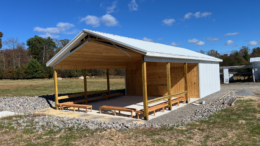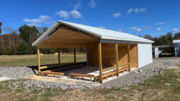In this article, you will find information that will allow you to maximize your garden space and yield by employing a few simple strategies—interplanting, relay planting, and succession planting.
If you are new to vegetable gardening, you are bound to find that in addition to good exercise, it will bring you tremendous satisfaction and joy. Here are ways to maximize your vegetable garden space and harvest.
Interplanting is defined as growing two or more different vegetable plants in the same space at the same time. This can occur in several ways – by alternating rows, mixing plants within a row, or distributing through the entire garden bed. For example, you can fill space in between slower growing crops like tomatoes or peppers with fast-to-mature crops such as lettuce, radishes, or scallions. Or, plant Brussels sprouts (slow-growing) with radishes or beets (fast-growing). Be sure to take into consideration light, nutrient, and moisture requirements of all species when interplanting. One such combination mixes onions, carrots, and lettuce. These three vegetables are compatible for interplanting because they have similar moisture needs, different rooting depths, as well as varying leaf forms that can help each with their respective light requirements.
Companion planting, grouping complementary plants together, is another means of interplanting and can serve a number of purposes beyond maximizing garden space. Companion planting can benefit your garden by providing needed nutrients, attracting beneficial insects and pollinators, and luring pests away from other food crops. For tomatoes, good companion plants include herbs such as basil, parsley and rosemary, and other vegetable plants including carrots, onions. Beans and peas are excellent companions in the garden; they can grow up the cornstalks and provide nitrogen to the soil to benefit the corn.
The second strategy for maximizing your garden is called relay planting. Relay planting, or staggering your installation of plants or seeds, will allow you to harvest a particular vegetable almost continuously throughout the growing season. By planting in two-week intervals, your supply of some of your favorite fresh vegetables can be extended. Instead of maturing all at once, a new crop will be ready as the earlier one nears its finish. Try this strategy with mesclun greens, Swiss chard, beets, bush beans, carrots, cucumber, radishes, or summer squash.
Succession planting is the third strategy for making the most of your garden space and involves planting new species in spots as earlier, mature plants are harvested. Planting corn after peas are finished producing, or squash after spinach is spent are two examples. The other and perhaps more encompassing approach to succession planting is to plan a three-season garden. This approach involves planting cooler crops in early spring such as broccoli and peas, followed by warmer summer crops such as tomatoes and peppers, and finally followed by more cool season crops – all grown in the same space. Take into consideration that daily sunlight hours decrease in fall slowing the plants’ growth. To be safe and ensure time for harvest, it is suggested that you add a week or two to the days-to-maturity time frame for your fall garden crops. This is temperature-dependent, of course. You may end up harvesting those fall crops a week early if temperatures remain favorable for vegetable production.
Gardening is a rewarding way to connect with nature and gain knowledge about and experience with our food crops. Employ one or more of the above strategies to assist you in maximizing your efforts in your vegetable garden this year. Most importantly, dig in the soil and have some fun! Enjoy the “veggies” of your labor!
Author
Rona Kauffmann
Master Gardener
York County









































